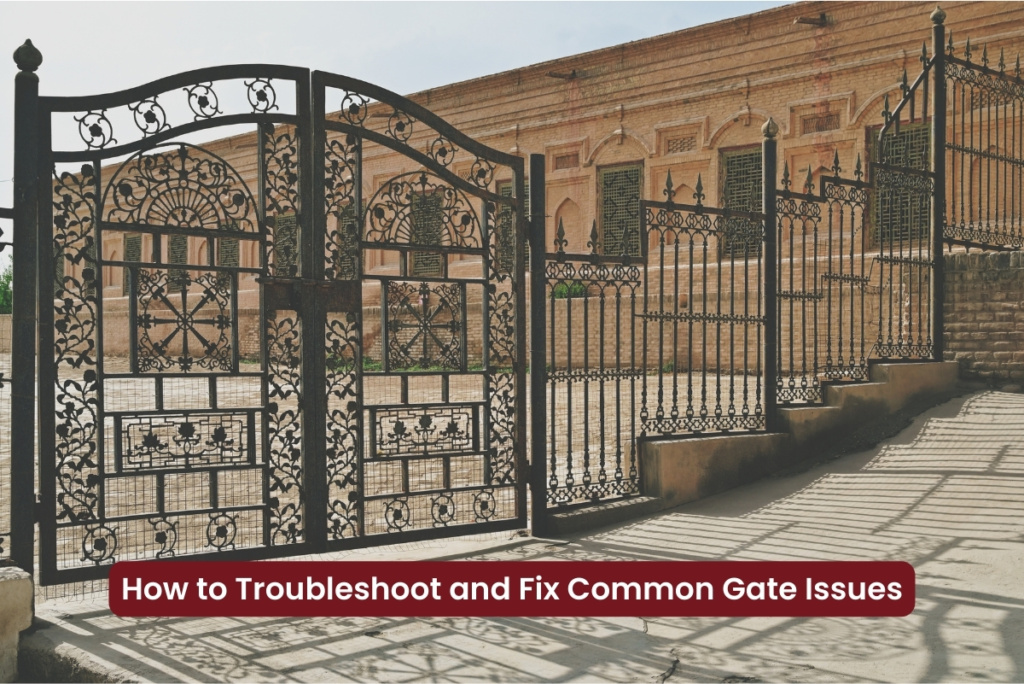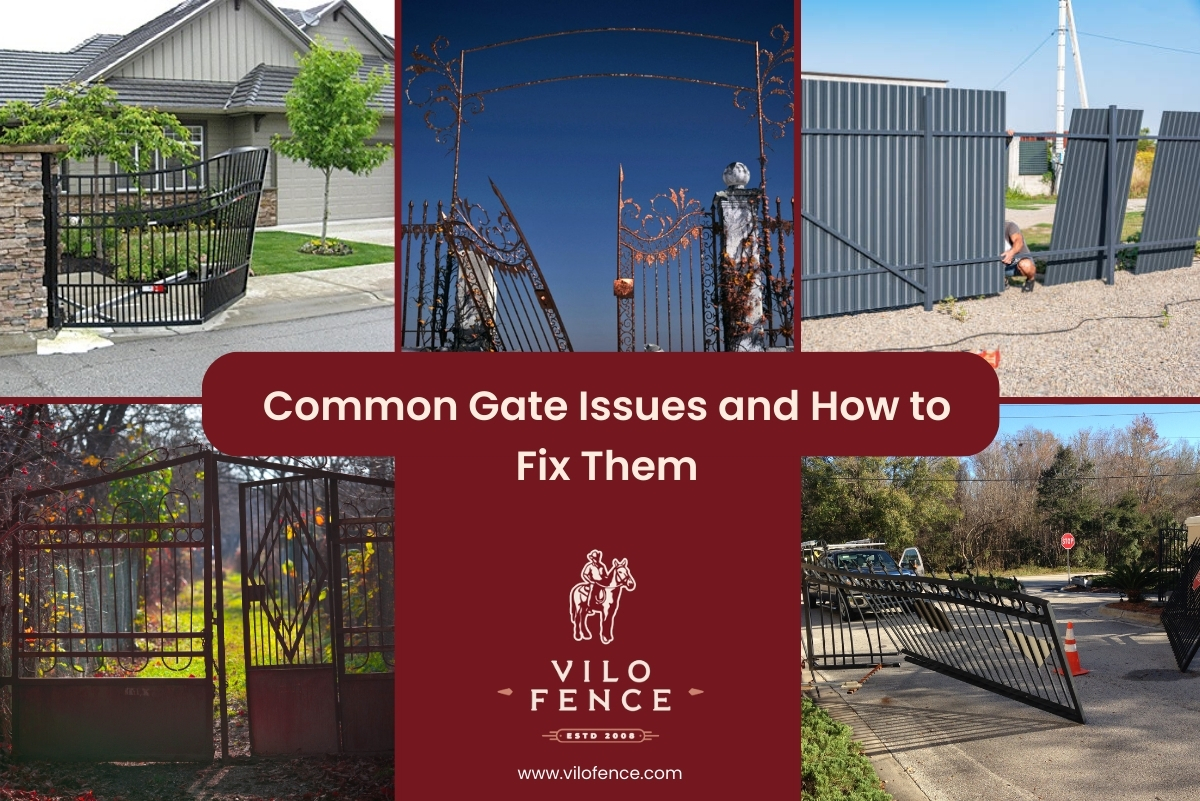A gate that doesn’t open, close, or function properly can be a major inconvenience. Whether it’s a cherished wooden gate, a sleek metal barrier, or an automatic entry system, any gate can face issues over time. But before you call a professional or replace it entirely, consider that many common gate problems have easy fixes.
In this blog, we’ll explore some of the most frequent gate issues homeowners face and show you simple, effective ways to restore your gate to its full potential—saving you both time and money in the process.
How to Troubleshoot and Fix Common Gate Issues

1. Gate Won’t Close or Open Properly
Possible Causes:
- Misalignment: Over time, gates can become misaligned, making them difficult to open or close.
- Worn-out hinges: Hinges bear the weight of the gate and can wear down or become damaged.
- Obstructions: Debris or dirt can accumulate at the base or in the track of automatic gates, preventing smooth operation.
How to Fix It:
- Align the Gate: Check for any visible signs of misalignment and adjust the gate’s position by loosening and realigning the hinges. Tighten them back up once the gate is correctly aligned.
- Replace Hinges: If the hinges are worn or damaged, replace them with high-quality ones that can bear the gate’s weight.
- Clear Obstructions: Ensure the tracks or sensors of automatic gates are free from any obstructions. Regular cleaning and maintenance can prevent this issue from recurring.
2. Rust and Corrosion on Metal Gates
Possible Causes:
- Metal gates are susceptible to rust and corrosion due to exposure to harsh weather conditions, especially rain and snow.
- Lack of protective coating or paint can accelerate the rusting process.
How to Fix It:
- Scrape and Clean the Affected Area: Use a wire brush to eliminate rust from metal surfaces. For larger areas, use sandpaper to smooth out the metal.
- Reapply Paint: After cleaning, apply a rust-resistant primer and a fresh coat of paint to protect the metal and prevent further corrosion.
- Use Anti-Rust Solutions: Consider using anti-rust solutions or sprays to prevent rust buildup in the future.
- Gate Is Stuck in the Open or Closed Position
Possible Causes:
- Faulty Latch or Lock: The gate may become stuck if the latch or lock mechanism is damaged or corroded.
- Worn-out Springs (for automatic gates): If you have an automatic gate, a faulty or broken spring can prevent it from functioning properly.
- Obstructions or Debris: As with opening or closing issues, debris buildup in the tracks or the gate’s mechanism can cause it to become stuck.
How to Fix It:
- Examine the Latch or Lock: Examine the lock for any visible signs of damage. If it’s rusty or jammed, clean or replace it. Sometimes, lubricating the mechanism with WD-40 can help resolve the issue.
- Replace the Spring: If the spring is broken or worn out, you may need to replace it. It’s best to call a professional if you’re unsure how to replace a spring in an automatic gate.
- Clear Debris: Regularly check the gate’s tracks or opening mechanisms for debris and clean them to avoid obstruction.
4. Squeaky Gate
Possible Causes:
- Lack of Lubrication: Hinges that are not properly lubricated can cause friction and produce squeaky noises.
- Worn-out Hinges: Hinges can wear down over time, causing them to squeak when the gate moves.
How to Fix It:
- Lubricate the Hinges: Apply a silicone-based lubricant to the hinges to reduce friction and eliminate the squeak. This is a quick and effective fix.
- Replace the Hinges: If lubrication doesn’t fix the issue, you may need to replace the worn-out hinges with new ones.
5. Automatic Gate Malfunctions
Possible Causes:
- Power Issues: A malfunction in the power supply, such as a blown fuse or dead battery, can prevent an automatic gate from functioning.
- Damaged Remote or Sensors: If the sensors or remote controls are faulty or misaligned, the gate may not respond to commands.
How to Fix It:
- Verify the Power Supply: Make sure the gate is properly receiving power. Check the fuse, wiring, and battery to rule out any electrical issues.
- Realign the Sensors: If the gate’s sensors are misaligned, it may fail to respond. Check the sensors and realign them if needed.
- Replace the Remote: If the remote control isn’t functioning, try replacing the batteries or consider replacing the entire remote if it’s damaged.
We hope, with these guidelines, you can fix persistent gate issues or if you require any professional help with installation or repairs, don’t hesitate to contact Vilo Fence. Our contractors specialize in all types of gate repair and provide long-term solutions.
Summary
In summary, gates are essential to your home or business, providing security and curb appeal. By understanding the common gate issues mentioned above, following the provided solutions, or choosing Vilo Fence, you can keep your gate functioning smoothly for years to come. Regular maintenance, such as cleaning, lubricating, and checking for wear and tear, will help you avoid major repairs and ensure your gate remains reliable.
FAQs
Q1. How can I stop rust from forming on my metal gate?
Ans. Clean the gate regularly and apply a rust-resistant primer to protect it from rust. You can also use anti-rust sprays to protect the metal from corrosion.
Q2. Why is my automatic gate not opening?
Ans. An automatic gate may not open properly due to power problems, malfunctioning sensors, or damaged springs. Check the power supply, realign sensors, or replace any faulty components.
Q3. How do I fix a squeaky gate?
Ans. Lubricate the hinges with a silicone-based lubricant to reduce friction. If the squeak persists, inspect and replace the hinges if necessary.






